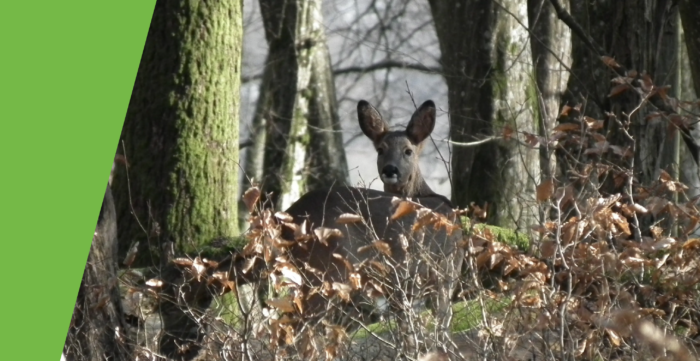
Forest dieback due to the climate crisis and excessive game populations: an appeal to the future government to regulate hunting
The forest is exposed to extreme climate stress. According to the forest condition inventory published at the end of September 2023, 85.5% of native trees are damaged, severely damaged or dying. This means that only 14.5% of trees are still healthy.
The analysis of the Lëtzebuerger Privatbësch shows that in the next ten years more than 30,000 hectares of forest (one third of the total forest) will have to be replanted with adapted tree species, either through natural regeneration or new planting. In addition to natural regeneration, this will require at least 100 million new young trees of various species.
However, this presupposes that the forest can also regenerate in a variety of ways. And this is precisely where the problem lies. This regeneration is currently not happening! The reason: the high density of hoofed game.
Roe deer, stags, fallow deer and mouflons eat the buds and leaves of the young trees so that they cannot regrow. Meanwhile, the numerous wild boar leave hardly any acorns and beechnuts to germinate, so that regeneration is also not possible.
The phenomenon is exacerbated by the fact that roe deer favour young oaks and rare thermophilic tree species. The consequence of this is that, at best, only the less palatable beech and spruce trees remain in a regeneration. However, we know that it is precisely these species that have the greatest difficulties with climate change and therefore cannot represent the future of the forest to the same extent. A vicious circle. The only way to preserve the forest – and thus the many services it provides for people (as a place of recreation, but also as a CO2 reservoir and to reduce the climate catastrophe) – is to reduce the wildlife population so that natural regeneration is feasible. The question is simply: how much game can the forest tolerate?
If game populations were not reduced, more than 10,000 kilometres of wooden fences or game fences would have to be erected over the next 10 years – at a cost of around 500 million euros – in order to ensure the growth of the new adapted forest generation. In addition to this considerable sum, this would mean that the forest would hardly be accessible to people, animal welfare would be considerably restricted, etc. A situation that nobody wants. A situation that nobody could wish for. It would be tantamount to a declaration of bankruptcy of forest management.
In view of the importance of our forests and the dramatic ecological and economic damage that is constantly occurring, we call on the new government to create the framework conditions to adjust game densities in such a way that the future of our forests is guaranteed.
Due to the lack of super-predators such as the wolf, the mild winters (which severely restrict natural selection) and inadequate hunting, game density is currently regulated by the food supply, i.e. also by the destruction of regeneration. The fatal consequence is that they are destroying their own habitat in the medium term. The following minimum targets are to be achieved: Set up crisis summit A crisis summit involving everyone must be held immediately: Private forest owners, public forest owners, environmental organisations, foresters, hunters and hunting syndicates, Prosilva and farmer representatives as observers.
The following minimum targets are to be achieved:
Set up crisis summit
A crisis summit involving everyone must be held immediately: Private forest owners, public forest owners, environmental organisations, foresters, hunters and hunting syndicates, Prosilva and farmer representatives as observers.
Creating acceptance for regulating hunting
- The influence of cloven-hoofed game on natural regeneration must be identified and measured by means of game fences and their monitoring;
- An adapted game density with the corresponding shooting quotas should be determined using scientific methodology.
Measure, assess and prevent game damage
- Develop a standardised nationwide evaluation system for game damage in forests;
- Nationwide recording of browsing damage by means of game fences and corresponding control areas – Systematic establishment of further game fences;
- Mandatory introduction of publicly funded scientific vegetation surveys in the entire forest, which can be used to determine damage;
- Recruitment of wildlife biologists to record and assess the damage caused by game browsing;
Facilitating the possibility of requesting compensation for damage – possibility toclaim for damage caused to the forest in the public forest.
Record game densities and set reduction targets
- Success of mixed regeneration measured according to scientific methods;
- Determination by the nature administration of minimum annual shootingnumbers to be respected (short-term recourse to foreign specialists);
- Extending hunting seasons and using modern methods to record game (thermalimaging and IR techniques);
- Prevention of population-building hunting, i.e. the targeted increase of the deerpopulation;•Maintaining the requirement to shoot mouflon and fallow deer.
Reform of the hunting law
- Adjustment of hunting forms and hunting times, including the use of technicalequipment such as residual light amplifiers and IR and UAV technology;
- Possibility of cancelling the lease contract for hunting lots if the shooting quotas havenot been reached for three consecutive years;
- Reform of the allocation of hunting lots: not only hunters may make the decisions,but forest owners must also be proportionally represented;
- Possibility of administration of the hunting lots by specially appointed foresters frommunicipalities or hunting syndicates in order to involve the local population ifnecessary;
- Possibility of an inspection licence system, both on the part of the state, themunicipalities, the hunting syndicates and the forest owners on their own initiativefrom a contiguous forest area of > 50 ha;
- Establish the quantitative recording of browsing damage as an integral part of hunting training and hunting examinations.
Valorisation and use of game meat
It is imperative to strengthen marketing chains for local game meat and, if possible, to enforce and consistently promote the certification of local game meat.
Only if the framework conditions are met will we be able to build up the biodiversity in the forest to mitigate climate change.
The climate catastrophe must continue to be combated. However, the proposals set out below are absolutely essential in order to initiate an appropriate climate adaptation strategy for our forests and prevent the worst from happening.
It is therefore all the more important that the central measure, which is of crucial importance for the protection of forests, is now finally being actively tackled: the reduction of game populations. To this end, the government should convene a crisis summit with all forest stakeholders. The aim of the summit is to work out solutions to preserve our forests for future generations. The undersigned organisations:
Fondation Hëllef fir d’Natur, FSC, Lëtzebuerger Privatbësch, Mouvement écologique, natur&ëmwelt asbl, PEFC, Prosilva, Wiltzer Waldverein
06.11.2023







